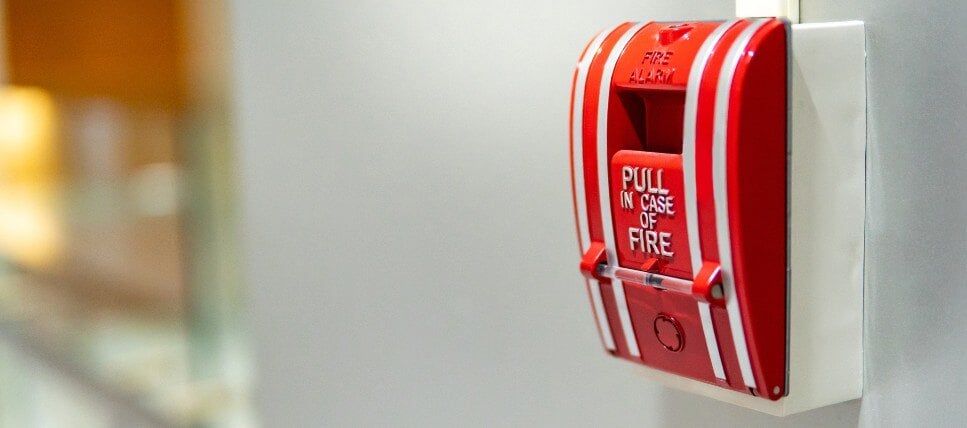There were 140,000 non-residential structure fires in 2022, according to the latest data available from the National Fire Protection Association (NFPA). Those fires led to 150 deaths, 1,400 injuries, and $4 billion in property damage.
Bottom line? Even though non-residential fires and deaths have dropped by more than 50% in the last 40 years, there’s still plenty of work to be done. New technologies can make a major difference, but only if they’re leveraged and implemented correctly in compliance with national and local regulations.
Unlike fire suppression systems, which combat fires, fire detection systems identify and alert occupants to the presence of a fire as quickly as possible so they can evacuate to safety. Understanding these systems is crucial for ensuring comprehensive safety in any building and remaining in compliance.
Designing a Compliant Fire Detection System
Designing an effective fire detection system requires careful consideration of several factors, including the type of building, its occupancy, and adherence to specific codes and standards. For instance, the NFPA provides guidelines on the placement and number of detectors based on the building's dimensions and usage. High ceilings, for example, necessitate more detectors due to the time it takes for smoke to reach the detectors.
The authority having jurisdiction often sets the requirements based on building type, size, and occupancy. For example, buildings with more than 600 occupants may require voice evacuation systems and elevators that automatically bring them to a safe floor during a fire.
Buildings where assemblies of 300 or more people happen, such as houses of worship or hotels and conference centers, require the installation of automatic sprinklers. Daycares and senior living facilities often have structure requirements as well. Fire detection systems are essential in many other scenarios, from kitchen fires in restaurants to ensuring that smoke doesn't spread through HVAC systems.
Some common fire detection system compliance requirements include:
- Fire alarm systems must have a secondary power source such as a dedicated storage battery or generator with at least 12 hours of capacity in the event the power grid goes down
- Manual fire alarm boxes (pull stations) must be located within 5 feet of an exit without obstructions and placed on the wall between 42–48”
- Smoke detectors cannot be located where airflow prevents the operation of the detectors, such as near HVAC vents
- Smoke detectors installed inside ductwork need to be rated and listed to ensure they work based on the air velocity, temperature, and humidity present in the duct
- Audible fire alarm systems must produce a decibel level that is at least 15 db above the average ambient sound or 5 db above the maximum sound level (an audio shunt may need to be installed to reduce/eliminate sound produced by sound systems and other entertainment systems to ensure the alarm is heard)
- Visible notification appliances like strobes should be located within 15 feet from the end of a corridor with a separation no more than 100 feet between appliances
This is just a small snapshot of the compliance requirements for fire and life safety systems, and some municipalities may require even more extensive mandates above and beyond NFPA standards. Working with a qualified provider who examines and understands your industry and your local regulations is critical.
Key Components of Fire and Life Safety Systems
Fire and life safety systems include a range of devices, sensors, and components designed to detect fires, alert occupants as early as possible, and notify authorities. These technologies can be configured in multiple ways depending on the building design and its intended use.
Some common components include:
- Detectors. Highly sensitive sensors detect smoke, heat, or carbon monoxide
- Pull Stations. Manual triggers, typically located near exits, allow occupants to activate the fire alarm
- Annunciators. Visual and audible notifications inform occupants of an active fire alarm
- Notification Appliances. Devices, such as flow switches and tamper switches, alert the fire system about conditions like water flow in the sprinkler system or smoke detection
- Elevator Recall/Emergency Phone. Elevator recall is initiated automatically by the fire detection system to relocate an elevator to a designated floor, and emergency phones can call out even if power is lost
These systems also integrate with other safety installations, such as sprinkler systems, Ansul systems in restaurant kitchens, or duct detectors in HVAC systems, to help provide a comprehensive safety net.
The Importance of Proper Maintenance and Fire Inspections
Fire and life safety systems are not a set-it-and-forget-it technology. Annual inspections and maintenance are critical to ensure they operate properly and that any structural changes over time are accounted for. Did a room get reconfigured with an additional wall or did renovations take place? Chances are, the system will need to be updated.
Regular testing and maintenance are vital to ensure a fire detection system functions correctly. Staying current with codes and standards is also essential to maintain compliance and safety. An experienced provider will help you remain in compliance and, more importantly, help keep your people and property safe.
For expert assessment and installation of fire and life safety systems, contact ASD. Our team of professionals is ready to help you enhance your building's safety with state-of-the-art fire detection solutions and life safety systems.



Leave a Comment